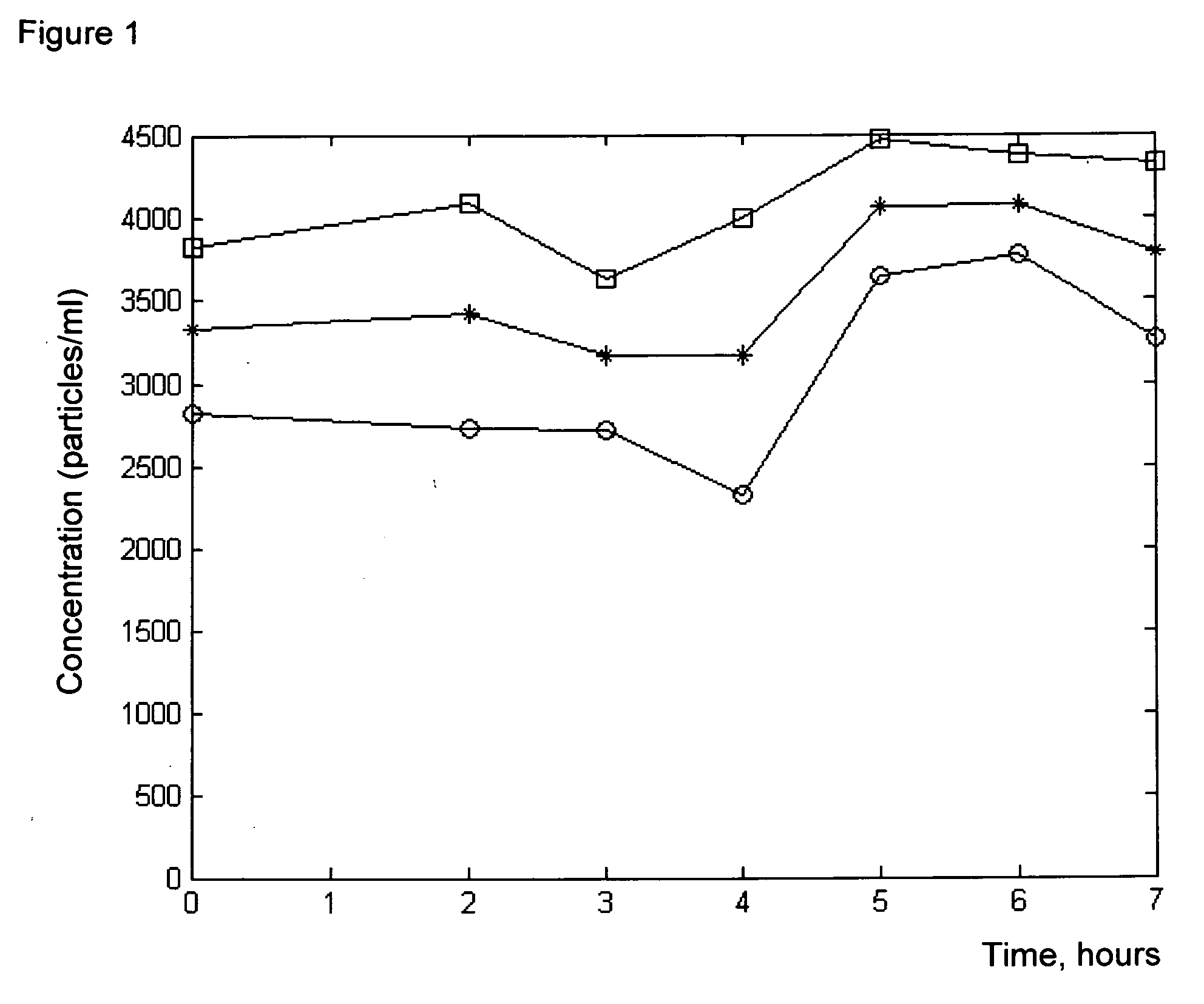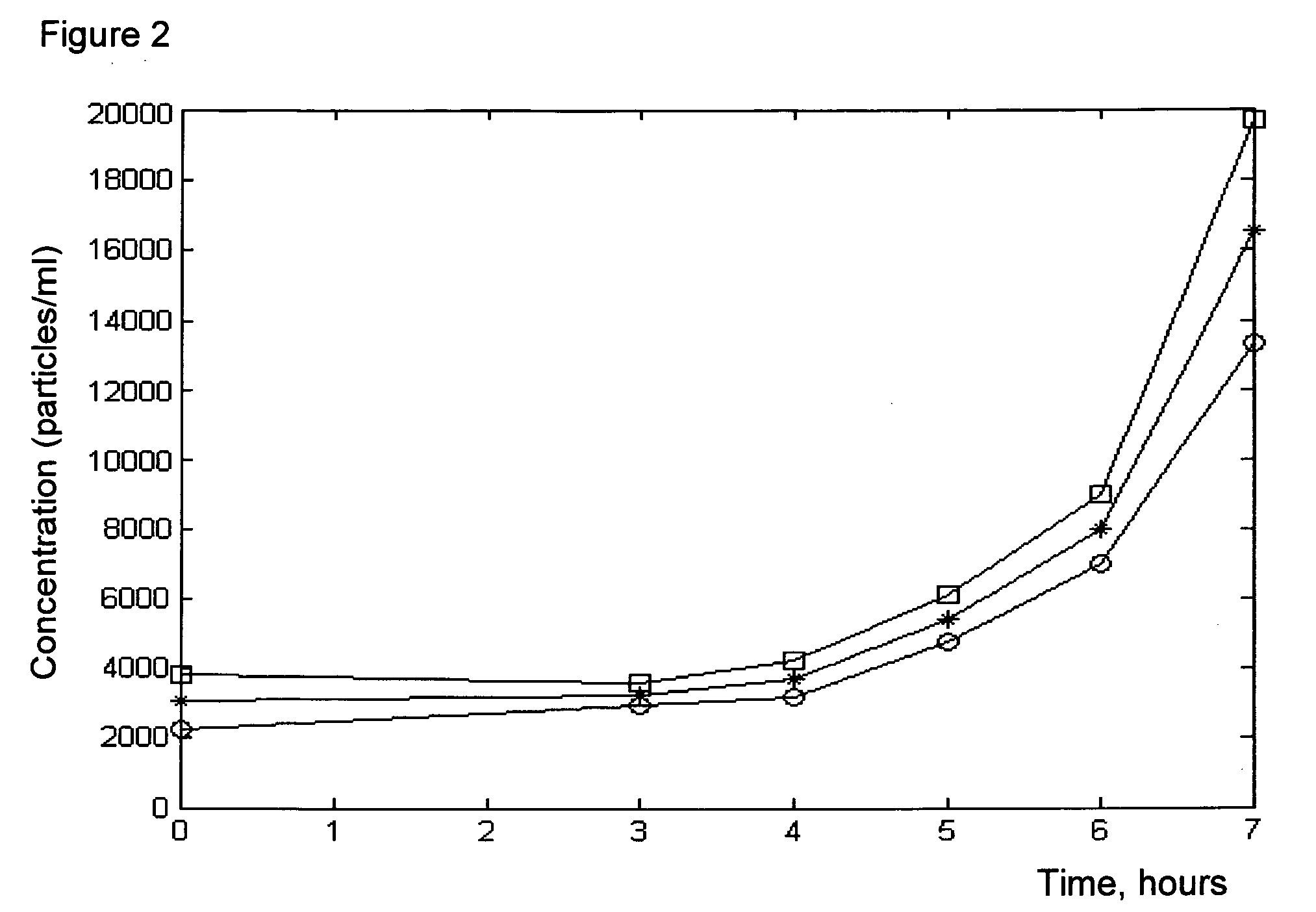Method for determining the quantity of microbiological objects during cultivation thereof
a technology of microorganisms and microorganisms, applied in the direction of microorganism testing/measurement, scattering properties measurement, instruments, etc., can solve the problem of large amount of microorganisms, inability to determine and inability to measure the optical density of solutions
- Summary
- Abstract
- Description
- Claims
- Application Information
AI Technical Summary
Benefits of technology
Problems solved by technology
Method used
Image
Examples
example 1
[0054]The study of Escherichia coli bacterial cells in a liquid medium No 1 (meat infusion broth) was conducted in accordance with requirements of the State Pharmacopoeia of Ukraine. For this purpose 10.0 g of dry fermentative peptone and 5.0 g of sodium chloride are dissolved under slow heating in a flask with 1 liter of meat water, 1.0 g of glucose is added for setting the pH level to be 7.3±0.2 after sterilization, and is simmered for 1 minute. The medium is filtered through a membrane filter with 0.2 μm pores, then sterilized in a steam sterilizer at 121° C. for 15 minutes. Escherichia coli bacterial cells are put into the medium at an initial concentration of 3300 cells / ml of medium. The so prepared solution of bacterial E. coli cells is bottled into sterile test tubes, 5 cm3 each, the tubes are closed with wadding-gauze corks, incubated in a thermostat at 30° C. Measurements of the dispersed light intensity by particles in the medium are carried out 7 times with an interval of...
example 2
[0056]The study of Escherichia coli bacterial cells in a liquid medium No 3 (enriched medium for detection of bacteria Enterobacteriaceae) was conducted in accordance with requirements of the State Pharmacopoeia of Ukraine. For this purpose 10.0 g of dry fermentative peptone, 7.5 g of Na2HPO4 and 2.5 g of KH2PO4 are dissolved under slow heating in a flask with 1 liter of meat water, 10.0 g of glucose, 8 ml of 1% phenol red solution and 3 ml of malachite green solution are added for setting the pH level to be 7.3±0.2 after sterilization. The medium is filtered through a membrane filter with 0.2 μm pores, then sterilized in a steam sterilizer at 121° C. for 15 minutes. Escherichia coli bacterial cells are put into the medium at an initial concentration of 3000 cells / ml of the medium. The prepared solution of bacterial E. coli cells is bottled into sterile test tubes, 5 cm3 each, the tubes are closed with wadding-gauze corks, and incubated in a thermostat at 40° C. Measurements of the ...
example 3
[0059]The study of Escherichia coli bacterial cells in a liquid medium No 3 (enriched medium for detection of bacteria Enterobacteriaceae) was conducted in accordance with requirements of the State Pharmacopoeia of Ukraine. For this purpose 10.0 g of dry fermentative peptone, 7.5 g of Na2HPO4 and 2.5 g of KH2PO4 are dissolved under slow heating in a flask with 1 liter of meat water, 10.0 g of glucose, 8 ml of 1% phenol red solution and 3 ml of malachite green solution are added for setting the pH level to be 7.3±0.2 after sterilization. The medium is filtered through a membrane filter with 0.2 μm pores, then sterilized in a steam sterilizer at 121° C. for 15 minutes. Escherichia coli bacterial cells are put into the medium at an initial concentration of 10000 cells / ml of medium (into 2 sterile 500 ml vessels). The prepared solution of bacterial E. coli cells from first vessel is bottled into sterile test tubes, 5 cm3 each, the tubes are closed with wadding-gauze corks, incubated in ...
PUM
 Login to View More
Login to View More Abstract
Description
Claims
Application Information
 Login to View More
Login to View More - R&D
- Intellectual Property
- Life Sciences
- Materials
- Tech Scout
- Unparalleled Data Quality
- Higher Quality Content
- 60% Fewer Hallucinations
Browse by: Latest US Patents, China's latest patents, Technical Efficacy Thesaurus, Application Domain, Technology Topic, Popular Technical Reports.
© 2025 PatSnap. All rights reserved.Legal|Privacy policy|Modern Slavery Act Transparency Statement|Sitemap|About US| Contact US: help@patsnap.com



